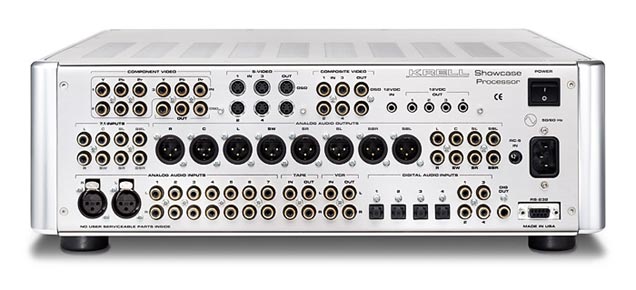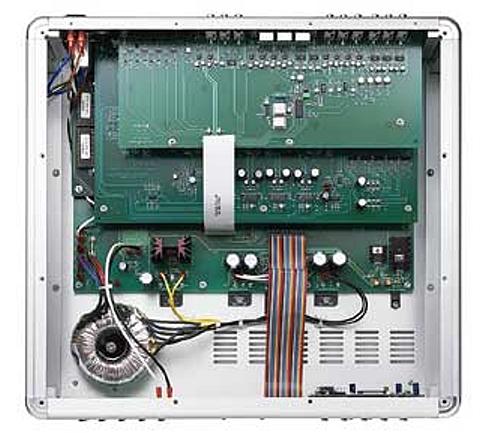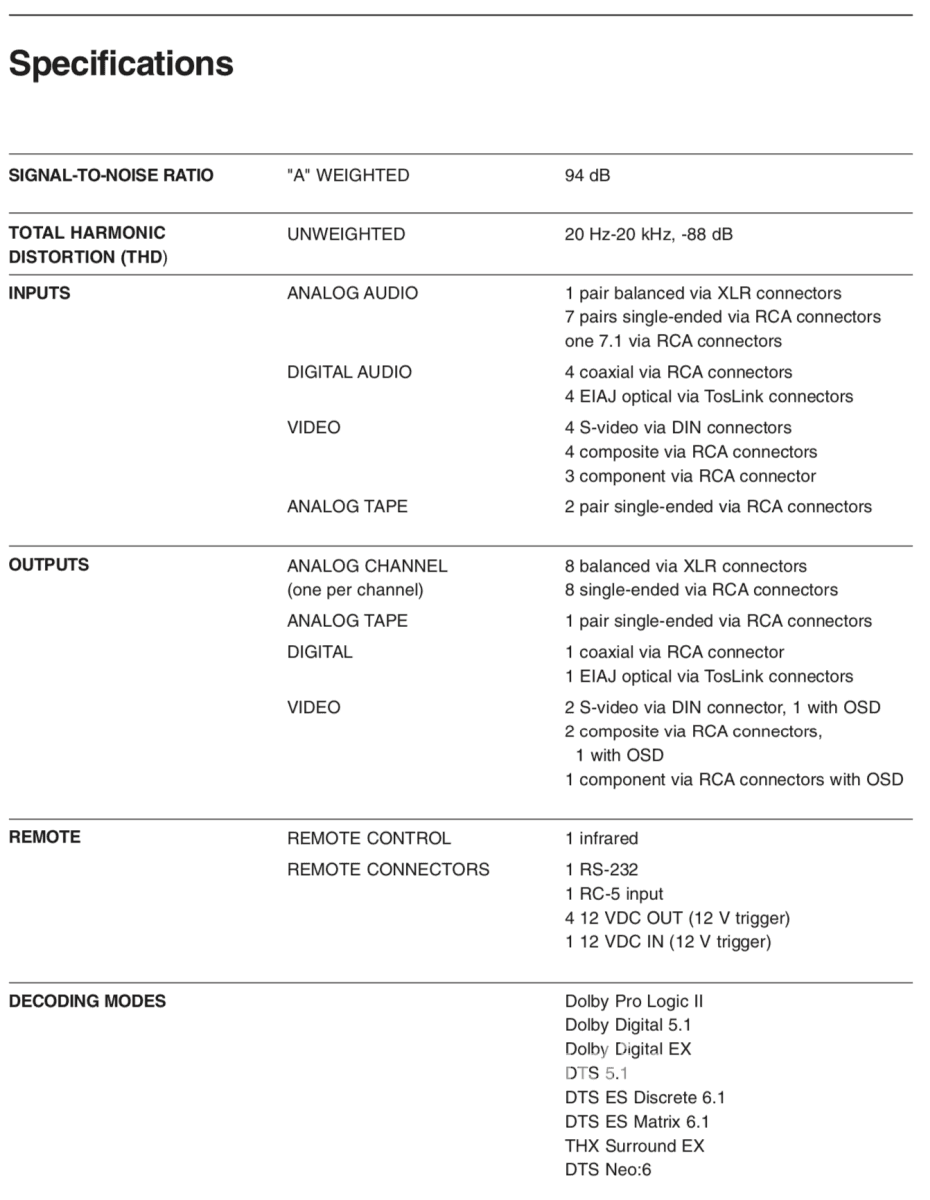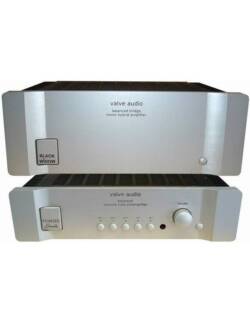Krell Showcase 7.1 preamp/Processor
Original price was: R150,000.00.R18,000.00Current price is: R18,000.00.
Introduction
One of the toughest decisions in Home Theater is deciding on which processor to use as the hub of your system. With so many choices and differences between products not always being obvious, making the right decision can be downright frustrating.
Krell has stepped up to the plate and now offers a solution in a price category never before entered by the audio heavyweight. Dubbed the ÒShowcaseÓ, this new surround sound processor (SSP) offers new levels of performance almost untouched by other offerings anywhere near this price point, with a level of flexibility and customization that is unmatched and that serious enthusiasts will probably really enjoy.
Design and Operation
Despite its rather low price point for a Krell piece, they have put the same touches on the Showcase as you will find on all their other KAV products. The processor is housed in the same brushed stainless steel chassis used in their higher line of models, like the HTS processor and DVD standard.
The front panel consists of a red LED display and the same small steel buttons found on their other units. Personally, I prefer a dial rather than buttons, but that is just me. This makes things a bit easier in a dark room. However, buttons are fine for many people.
From the front panel you can choose your input, surround mode, and manipulate any of the menu functions. Selecting the input is rather easy, but using the panel to select the surround mode and other functions takes some getting used to. While the manual does do a decent job of walking you through these controls, even a seasoned veteran of A/V equipment will find himself scratching his head at first (as one does with just about any consumer electronics instruction manual). Gone are the days when there was just an on-off button, volume control, and channel selector.
The display is red with red lettering, which is difficult to read from a distance. The display, like most Krell products, turns itself off after a few moments of non use. This is great for those wishing to have a total blackened room, since it doesn’t add to the ambient light. However, the power indicator LED is a blue light that is very bright. I had to tape over it since it illuminated the entire rear portion of the room. This is not an issue if you like panel displays being lit up, or if you are using an enclosed rack for your equipment.
The back panel offers everything you’d expect from a high end pre/pro. All the inputs are assignable and grouped together by function. This means all the component video inputs are together and labeled one, two, three etc. You can assign any video input to any audio input using the on-screen setup menus. XLR jacks are numerous here, which is something you expect from a top notch manufacturer like Krell.

On the video side, you get three sets of component video inputs (with 80 MHz bandwidth for HD switching) for DVD or High Definition sources, and one output. I did find it unusual that you must specify whether the input source is interlaced or progressive/HD in the setup menu. By stating that the source is progressive or HD, you cannot pass an interlaced source through that particular input, and you also disable the OSD for that source. There are four S-Video and four composite video inputs. There are two outputs for each of these two input types, one for the OSD and one for a recording loop.
Upon inspection of the inside of the chassis, I noticed that Krell has included some nice touches for their video switcher. All of the video components are found on one card that is separated from the rest of the processing. It also uses very high quality video mutiplexers that shut off all video sources except the one selected. This ensures that one input doesn’t affect another.
On the audio side, there is a wealth of connections as well. There are seven assignable analog stereo inputs, as well as a balanced stereo input for high end CD transports. For SACD and DVD-A buffs, the Showcase offers an eight channel analog pass-through input. This bypasses any analog to digital conversion and serves basically as a preamp section with only volume control applied. However, in the setup menus you must select which channels you are using so that the processor can shut off the unused inputs to alleviate interference.
For digital connections, there are four Toslink inputs and four coaxial digital inputs as well as one digital coaxial out for recording purposes. Like every other input, these are assignable to any source. You also have the ability to pre-assign the default surround format for the input in the setup menu. This means if you want the DVD input to always default to 5.1 Dolby Digital and THX post processing you can set this up initially and not worry about it again. This is nice, since the Krell uses very high quality relays which tend to be slow and noisy when auto detecting a format. You can also set up a delay of up to twenty seconds for layer changes or movie trailers, so that the processor doesn’t jump in and out of surround modes when there are small delays on the disc.
As to pre-outs, you have two flavors to choose from. There is a 7.1 channel analog output as well as a balanced 7.1 channel output. I recommend the balanced output for two reasons. First off, balanced cables tend to be less affected by outside interference from other cables, and the connection tends to be a lot sturdier since the terminations lock into place. Balanced outputs also have less noise in longer runs so those of you using active speakers or mono-block amplifiers spread across the room will probably want to take advantage of this.
When you look inside the Showcase you’ll notice that all of the audio circuits have been separated in a similar fashion to the video ones. On the bottom of the chassis are the main DSP board and DACs. Sandwiched between it and the video card is the Op Amp board. Here you’ll find the Crystal Semiconductor volume control chips as well as the Op Amps. The volume control digitally controls analog volume with 1 dB increments and has the ability to set pre-programmed volume levels to sources.
The volume readout is relative, with 0 meaning no volume, and 100 being maximum. Not that you would ever go that far. THX Reference level is 31 and the letter R appears next to this volume. I never needed to venture past this setting and the processor allows you to set a maximum volume level to prevent overdriving your setup. It also defaults to this volume when you use the internal test tones to set your speaker levels. The industry standard way to denote volume is absolute, where infinity is no volume and 0 dB is reference.

The Op Amps are Analog Devices OP275s. These are high quality amps that don’t have the heat problems associated with many Op Amps. Krell has dedicated one stereo amp per channel. These Op Amps allow the balanced outputs to have a lot more resistance to feedback from the amplifier it’s coupled to.
Setup In a Snap !
Setting up the Krell is rather simple initially. The on-screen menus can be displayed through any available video output with the exception of component video outputs that are set to progressive/HD. If you want to display the menus through a certain type of output such as S-Video, you simply select an S-Video source. The first steps in the setup options are identifying the video sources and assigning an input for them. You also must select whether they are PAL or NTSC sources. Also of note, the Showcase comes pre-programmed with a default setup. Most common sources are already set up like most people would use them. For example, if you were to select DVD as the source, the processor is pre-configured for Component Video one, digital coax audio and Dolby Digital 5.1 decoding. Other sources such as VCR and satellite are set up for Pro Logic 2 (DPL-II) movie mode which would make sense. While I always configure an SSP to my personal liking, the fact that this processor was already pre-programmed with some forethought makes it easy for the novice enthusiast who isn’t familiar with all the ins and outs of setup procedures, and just wants to start watching movies with minimum hassle.
The audio setup is quite extensive, with a lot of options available. This is performed in a few different stages. There is the assignment of digital and analog inputs, as well as the default surround format you want. You can choose any surround mode, stereo mode, or just straight bypass. There is also a setup for sources that are 5.1, 6.1, and 7.1. Here, you tell the processor the size of your speakers for each individual configuration and how many speakers are used in the rear (1 or 2 – such as the case in 7.1 with 2 speakers on the side and 1 or 2 in the rear).
When setting the size, there are two choices – Full Range and Limited. The limited function allows you to set a universal crossover point for your smaller speakers. The range for the crossover frequencies is 40 Hz- 120 Hz in 20 Hz steps. This setup menu also allows the user to configure which surround speakers should be used for which purposes. In other words, it gives you the option to use the rear speakers for surrounds in 5.1 if you prefer them over the side surround speakers. It also allows you to use both the rear and side surround speakers for 5.1 material using a matrix algorithm developed by Krell. This is similar to THX Ultra 2 processing for movies, although I felt the THX processing did a slightly better job with imaging.
When you are finished with the bass management setup and speaker identification, you move on to delay settings. These are made in one foot increments. I would have preferred to see smaller increments used, but I was able to get my speakers very close to the measurement I selected. You then move on to setting your levels using either the test tones supplied by the processor or tones generated from a test disc. The processor automatically defaults to its ÒreferenceÓ volume in this stage so that you don’t have to adjust the volume control just for the setup.
In the main setup menus, you’ll also find all the controls for various DSP modes such as DPL-II and DTS Neo:6. You also have the ability to set processing delays for certain soundtracks. These allow the processor to stay in a surround mode although only two channels are present. Since the Krell has an audible click when it switches modes, and has a rather lengthy delay, this feature eliminates gaps in the soundtrack that may result from breaks in the material.
Another handy feature found here is a bass limiter. This is becoming a standard on most SSPs and receivers (it is supposed to be present in all THX SSPs), and it allows the user to set an overall limit on bass information directed to either the mains or your sub to avoid overdriving your speakers. We recommend this to anyone who has bookshelf speakers and outboard power amplifiers of limited power (e.g., 100 watts per channel).
Once you are finished with the initial setup, the Krell Showcase processor offers a parametric equalizer for each channel, giving an unheard of amount of flexibility to the end user. In fact, such a feature is unusual in SSPs at any price. There are four memory modes that can be set up, allowing the user to make adjustments based on the source material. This means you can have one memory for movie playback, another for music, and one or two just to drive your neighbors crazy.
Filters for the equalizer include Notch, Peaking, High Pass, Low Pass, High Shelf, and Low Shelf. These filters allow you to dial in the sound to your room. For those not familiar with parametric equalizers, they allow you to flatten the response of the room by dealing with peaks and valleys in the overall room response. While this function cannot completely eliminate these problems, it can go a long way in dealing with certain issues. If you want to go the extra mile and use acoustic treatments as well, you can be sure that almost any problem with your room’s response can be handled.
To really take advantage of this feature we would advise the use of a real time analyzer (RTA) or even an acoustic program for the PC. While these types of adjustments can be made using an SPL meter, it can be quite difficult. I was not able to fully utilize this function as I would have liked.
A really nice addition to this processor would have been the inclusion of an outboard microphone for the setup and processing features, similar to Pioneer’s new receivers. You put the microphone in the seating position, and the processor or receiver then goes through a series of tones, automatically making adjustments in loudness, delays, and frequency response. Note that it is always best to bring peaks down rather than trying to raise the valleys. We suspect that such automatic configuration processing with be a staple on SSPs and receivers within a few years. Whoever comes up with the best little chip for that procedure will make a lot of money.
Your Audio in 31 Flavors
As you would expect from a high end digital processor, all the requisite surround modes are covered, as well as including some that Krell has come up with. The Showcase is a certified THX Ultra product and therefore THX post-processing can be applied to any source. This includes THX Surround EX processing. The Showcase did an excellent job detecting the EX flags on DVDs that have been properly encoded, but like most other processors, I had to activate the processing for those DVDs that weren’t flagged.
There was also the inability to deactivate Re-EQ from the THX processing. There are some studios releasing DVDs that have been mixed with home theater in mind and don’t benefit from this processing. The new Ultra 2 spec mandates that THX products offer the ability to turn off this function if desired.
On the Dolby side, the Showcase has the standard 5.1 processing as well as the newer DPL-II music and movie modes. It does not feature Dolby Surround EX processing though. To properly decode these tracks you will need to use THX EX processing. This is a problem because it doesn’t allow independent selection of Re-Eq. If it did, there would be no need whatsoever for Dolby Digital EX in addition to THX Surround EX. However, I didn’t mind this at all since I always use THX processing for movie playback anyway, but I am aware that there are those who don’t want to use it.
Krell also offers a DSP mode which will decode the back channels using their own algorithms. This would enable you to use the rear channels without the THX processing but it is not the same as Dolby Digital EX. While I did think the DSP mode did a fairly good job with test material, including “Blade 2” and “Star Wars Episode 2”, I thought the THX EX processing edged it out in terms of transparency when sounds panned across the stage. Of course, this was just my preference.
For DTS processing, the Showcase offers 5.1 music and movie modes and the new DTS ES variants. For two-channel material, the new DTS Neo:6 is also included. There have been many debates about which decoding method, DPL-II or Neo 6, is better. Both have their merits, and I am glad Krell has left it up to the customer as to which one to use.
Most of the new processors on the market are using single chip DSP engines to achieve their decoding. Popular offerings from companies like Anthem, B&K, and Aragon are examples. While companies can offer upgrades, most of the time it comes at a cost to the end consumer. The Showcase has been equipped with two very powerful DSP engines. For all of the multi-channel decoding such as Dolby Digital, DTS, as well as the bass management and setup functions, the Showcase employs the Crystal Semiconductor 49326 DSP engine. This chip is fully capable of satisfying all the needs of the current offerings of both DTS and Dolby.
For THX processing, the Showcase employs a second DSP engine, the Crystal 49330. This chip was specifically designed by Crystal Semiconductor to be used in THX applications. It is capable of all THX post processing, including the new Ultra 2 requirements, although Ultra 2 processing isn’t offered on the Showcase. This DSP also provides the processing power for the parametric functions. I asked Krell if the Showcase will be updated to the new Ultra 2 specification anytime soon, and they said that, at the present moment, there are no plans to do so. However, it is reassuring to know that the processor has the head room for future upgrades and won’t require hardware changes to accomplish it. Buyers may also be interested in knowing that both of these DSP engines are what Krell uses in its top of the line Home Theater Standard 7.1 processor.
For the audio purist, the Krell Showcase has a preamp mode that is a straight analog pass through (no processing of any kind, just volume control and preamplification, direct to the output jacks). I used this extensively and was overjoyed with the results. The 7.1 analog input defaults to this mode as does the two channel balanced inputs. I fed it with Krell’s DVD Standard using the balanced inputs and used the preamp mode for two channel listening. The imaging was very accurate, and I noticed no fillers or other introductions from the Showcase. As good as the Showcases DACs are, I found the DVD Standard’s to be slightly better in terms of refinement in details. However, both are very neutral.
Sounds Like a Winner . . .
Without a doubt the Krell Showcase is the best processor I have had the pleasure of using in my system. It increased the depth of my soundstage quite a bit over others I have tested. When I listened to film soundtracks, the front soundstage had a great transparency and excellent dynamic range. Bass seemed tighter and more focused than before, and there wasn’t a hard edge to any of the higher frequencies.
The Showcase employs two different DACs for its various channels. For the front mains, Texas Instruments (formerly Burr Brown) PCM 1737s are used. These are a delta sigma DAC that samples at 192 kHz with a 24 bit word depth. For all other channels, they use T.I.’s 1605 DAC. It is also a 192 kHz/ 24 bit converter, but it is made to handle more channels. Krell has focused its best quality on the front mains, since two-channel is their passion. It seems a good choice, since I never once thought any of the channels sounded off in any way. Like the DSPs mentioned before, these DACs are the same ones used in the more expensive Krell HTS 7.1 processor.
For music, I would categorize the Showcase as a very neutral piece. As with movies, the soundstage offered excellent dynamics. Most recordings seemed richer when I listened to them, especially in the lower end. It did especially well with precise notes like a rolling cymbal. Instead of the milky sound that blends into itself that I hear with a lot of audio pieces it seems, the Showcase offered a discernable distant sound with tiny details. Krell has definitely proved that it can still provide excellent audio performance at a reasonable price.
Okay, with all these nice things to say I guess I should complain about something, the remote. If there is a shortfall to the Showcase, this is it. Krell went with the same remote they use on their other equipment, and I cannot fathom why. Just barely larger than a credit card and extremely thin, this remote is just about impossible to use in a dark room. The buttons are all exactly the same shape and feel, and only a slight few (the menu navigation buttons) are laid out in a way that you can tell what they are by touch. I would strongly recommend the use of a separate remote for this unit. It will save you a lot of aggravation. Perhaps Krell assumes most people will use their own remote control anyway, so they just provide this one as a token.
If you have $4,000 to spend on an SSP, the Showcase should be on your short list to audition. Keep in mind that the Showcase has almost all the same internal parts as its big brother the Home Theater Standard 7.1. They both utilize the same DACs and DSP engines. The only differences I could find between the two were the HTS’s second zone and its modular design. I was not able to directly compare the analog sections of the two as this would require the schematics for the two pieces and I am quite sure Krell would have issues with their release.
The Showcase offers a flexibility that is not found anywhere else at this price point, and sound quality that would please even the most discerning audiophile. I really can’t find much to gripe about. If you are in the market for a processor, make sure and look into this one, because I think it will make your shopping very, very easy.
Description












